The Use of Mining Waste Materials for the Treatment of Acid and Alkaline Mine Wastewater
Abstract
:1. Introduction
2. Materials and Methods
2.1. Site Description
2.2. Waste Materials
2.2.1. Acid Mine Drainage
2.2.2. Alkaline Flotation Wastewater
2.2.3. Mine Waste Rocks
2.3. Sample Collection and Data Acquisition
2.3.1. Chemical Analysis of Wastewaters (AMD and Flotation Wastewater)
2.3.2. Geochemical Analysis of Waste Rocks
2.3.3. Titration with Mine Wastewater
2.3.4. Mine Water Neutralization by Waste Rocks
3. Results
3.1. Characterization of Waste Rock
3.2. Characterization of Mine Wastewater
3.3. Flotation Wastewater Neutralization by Acid Mine Drainage
3.4. Mine Wastewater Neutralization by Waste Rock—Batch Test 1
3.5. Mine Wastewater Neutralization by Waste Rock—Batch Test 2
4. Discussion
5. Conclusions
Supplementary Materials
Author Contributions
Funding
Conflicts of Interest
References
- Lottermoser, B.G. Mine Wastes: Characterization, Treatment and Environmental Impacts, 3rd ed.; Springer: Berlin/Heidelberg, Germany, 2010. [Google Scholar] [CrossRef]
- Lottermoser, B.G. Recycling, reuse and rehabilitation of mine wastes. Elements 2011, 7, 405–410. [Google Scholar] [CrossRef]
- Hudson-Edwards, K.A.; Jamieson, H.E.; Lottermoser, B.G. Mine Wastes: Past, Present, Future. Elements 2011, 7, 375–380. [Google Scholar] [CrossRef]
- Bian, Z.; Miao, X.; Lei, S.; Chen, S.; Wang, W.; Struthers, S. The Challenges of Reusing Mining and Mineral-Processing Wastes. Science 2012, 337, 702–703. [Google Scholar] [CrossRef] [PubMed]
- Sarmiento, A.M.; DelValls, A.; Nieto, J.M.; Salamanca, M.J.; Carballo, M.A. Toxicity and potential risk assessment of a river polluted by acid mine drainage in the Iberian Pyrite Belt (SW Spain). Sci. Total Environ. 2001, 409, 4763–4771. [Google Scholar] [CrossRef] [PubMed]
- Grande, J.A.; Santisteban, M.; de la Torre, M.L.; Davila, J.M.; Perez-Ostale, E. Map of impact by acid mine drainage in the river network of The Iberian Pyrite Belt (Sw Spain). Chemosphere 2018, 199, 269–277. [Google Scholar] [CrossRef]
- Byrne, P.; Wood, P.J.; Reid, I. The impairment of river systems by metal mine contamination: A review including remediation options. Crit. Rev. Environ Sci. Technol. 2012, 42, 2017–2077. [Google Scholar] [CrossRef]
- Iribar, V.; Izco, F.; Tames, P.; Antiguedad, I.; da Silva, A. Water contamination and remedial measures at the Troya abandoned Pb-Zn mine (The Basque Country, Northern Spain). Environ. Geol. 2000, 39, 800–806. [Google Scholar] [CrossRef]
- Lebre, E.; Corder, G.D.; Golev, A. Sustainable practices in the management of mining waste: A focus on the mineral resource. Miner. Eng. 2017, 107, 34–42. [Google Scholar] [CrossRef]
- Durucan, S.; Korre, A.; Munoz-Melendez, G. Mining life cycle modelling: A cradle-to-gate approach to environmental management in the minerals industry. J. Clean. Prod. 2006, 14, 1057–1070. [Google Scholar] [CrossRef]
- Simate, G.S.; Ndlovu, S. Acid mine drainage: Challenges and opportunities. J. Environ. Chem. Eng. 2014, 2, 1785–1803. [Google Scholar] [CrossRef]
- Dold, B. Evolution of Acid Mine Drainage Formation in Sulphidic Mine Tailings. Minerals 2014, 4, 621–641. [Google Scholar] [CrossRef] [Green Version]
- Yuniati, M.D.; Kitagawa, K.; Hirajima, T.; Miki, H.; Okibe, N.; Sasaki, K. Suppression of pyrite oxidation in acid mine drainage by carrier microencapsulation using liquid product of hydrothermal treatment of low-rank coal, and electrochemical behavior of resultant encapsulating coatings. Hydrometallurgy 2015, 158, 83–93. [Google Scholar] [CrossRef]
- Li, X.; Hiroyoshi, N.; Tabelin, C.B.; Naruwa, K.; Harada, C.; Ito, M. Suppressive effects of ferric-catecholate complexes on pyrite oxidation. Chemosphere 2019, 214, 70–78. [Google Scholar] [CrossRef]
- Igarashi, T.; Herrera, P.S.; Uchiyama, H.; Miyamae, H.; Iyatomi, N.; Hashimoto, K.; Tabelin, C.B. The two-step neutralization ferrite-formation process for sustainable acid mine drainage treatment: Removal of copper, zinc and arsenic, and the influence of coexisting ions on ferritization. Sci. Total Environ. 2020, 715, 136877. [Google Scholar] [CrossRef]
- Chopard, A.; Benzaazoua, M.; Bouzahzah, H.; Plante, B.; Marion, P. A contribution to improve the calculation of the acid generating potential of mining wastes. Chemosphere 2017, 175, 97–107. [Google Scholar] [CrossRef]
- Park, I.; Tabelin, C.B.; Jeon, S.; Li, X.; Seno, K.; Ito, M.; Hiroyoshi, N. A review of recent strategies for acid mine drainage prevention and mine tailings recycling. Chemosphere 2019, 219, 588–606. [Google Scholar] [CrossRef]
- Akcil, A.; Koldas, S. Acid Mine Drainage (AMD): Causes, treatment and case studies. J. Clean. Prod. 2006, 14, 1139–1145. [Google Scholar] [CrossRef]
- Schaider, L.A.; Senn, D.B.; Estes, E.R.; Brabander, D.J.; Shine, J.P. Sources and fates of heavy metals in a mining-impacted stream: Temporal variability and the role of iron oxides. Sci. Total Environ. 2014, 490, 456–466. [Google Scholar] [CrossRef] [Green Version]
- Soni, A.K.; Mishra, B.; Singh, S. Pit lakes as an end use of mining: A review. J. Min. Environ. 2014, 5, 99–111. [Google Scholar] [CrossRef]
- Tomiyama, S.; Igarashi, T.; Tabelin, C.B.; Tangviroon, P.; Li, H. Acid mine drainage sources and hydrogeochemistry at the Yatani mine, Yamagata, Japan: A geochemical and isotopic study. J. Contam. Hydrol. 2019, 225, 103502. [Google Scholar] [CrossRef]
- Kefeni, K.K.; Msagati, T.A.M.; Mamba, B.B. Acid mine drainage: Prevention, treatment options, and resource recovery: A review. J. Clean. Prod. 2017, 151, 475–493. [Google Scholar] [CrossRef]
- Pyrbot, W.; Shabong, L.; Singh, O.P. Neutralization of acid mine drainage contaminated water and ecorestoration of stream in a coal mining area of east Jaintia Hills, Meghalaya. Mine Water Environ. 2019, 38, 551–555. [Google Scholar] [CrossRef]
- Fosso-Kankeu, E.; Mittal, H.; Waanders, F.; Ray, S.S. Thermodynamic properties and adsorption behavior of hydrogel nanocomposites for cadmium removal from mine effluents. J. Ind. Eng. Chem. 2017, 48, 151–161. [Google Scholar] [CrossRef]
- Kaartinen, T.; Laine-Ylijoki, J.; Ahoranta, S.; Korhonen, T.; Neitola, R. Arsenic removal from mine waters with sorption techniques. Mine Water Environ. 2017, 36, 199–208. [Google Scholar] [CrossRef]
- Garcia, V.; Hayrynen, P.; Landaburu-Aguirre, J.; Pirila, M.; Keiski, R.L.; Urtiaga, A. Purification techniques for the recovery of valuable compounds from acid mine drainage and cyanide tailings: Application of green engineering principles. J. Chem. Technol. Biotechnol. 2013, 89, 803–813. [Google Scholar] [CrossRef]
- Wingenfelder, U.; Hansen, C.; Furrer, G.; Schulin, R. Removal of heavy metals from mine waters by natural zeolites. Environ. Sci. Technol. 2005, 39, 4606–4613. [Google Scholar] [CrossRef]
- Tabelin, C.B.; Igarashi, T.; Villacorte-Tabelin, M.; Park, I.; Opiso, E.M.; Ito, M.; Hiroyoshi, N. Arsenic, selenium, boron, lead, cadmium, copper, and zinc in naturally contaminated rocks: A review of their sources, modes of enrichment, mechanisms of release, and mitigation strategies. Sci. Total Environ. 2018, 645, 1522–1553. [Google Scholar] [CrossRef]
- Jacobs, J.A.; Lehr, J.H.; Testa, S.M. (Eds.) Acid Mine Drainage, Rock Drainage, and Acid Sulfate Soils. Causes, Assessment, Prediction, Prevention, and Remediation; John Wiley & Sons, Inc.: Hoboken, NJ, USA, 2014. [Google Scholar] [CrossRef]
- Offeddu, F.G.; Cama, J.; Solera, J.M.; Dávila, G.; McDowell, A.; Craciunescu, T.; Tiseanu, I. Processes affecting the efficiency of limestone in passive treatments for AMD: Column experiments. J. Environ. Chem. Eng. 2015, 3, 304–316. [Google Scholar] [CrossRef] [Green Version]
- Othmani, M.A.; Souissi, F.; Bouzahzah, H.; Bussiere, B.; Silva, E.F.; Benzaazoua, M. The flotation tailings of the former Pb-Zn mine of Touiref (NW Tunisia): Mineralogy, mine drainage prediction, base-metal speciation assessment and geochemical modeling. Environ. Sci. Pollut. Res. 2015, 22, 2877–2890. [Google Scholar] [CrossRef]
- Ciarkowska, K.; Hanus-Fajerska, E.; Gambus, F.; Muszynska, E.; Czech, T. Phytostabilization of Zn-Pb ore flotation tailings with Dianthus carthusianorum and Biscutella laevigata after amending with mineral fertilizers or sewage sludge. J. Environ. Manag. 2017, 189, 75–83. [Google Scholar] [CrossRef]
- Stankovic, V.; Milosevic, V.; Milicevic, D.; Gorgievski, M.; Bogdanovic, G. Reprocessing of the old flotation tailings deposited on the RTB Bor tailings pond—A case study. Chem. Ind. Chem. Eng. Q. 2018, 24. [Google Scholar] [CrossRef]
- Khalil, A.; Argane, R.; Benzaazoua, M.; Bouzahzah, H.; Taha, Y.; Hakkou, R. Pb–Zn mine tailings reprocessing using centrifugal dense media separation. Miner. Eng. 2019, 131, 28–37. [Google Scholar] [CrossRef]
- Antonijevic, M.M.; Dimitrijevic, M.D.; Stevanovic, Z.O.; Serbula, S.M.; Bogdanovic, G.D. Investigation of the possibility of copper recovery from the flotation tailings by acid leaching. J. Hazard. Mater. 2008, 158, 23–34. [Google Scholar] [CrossRef] [PubMed]
- Kuhn, K.; Meima, J.A. Characterization and Economic Potential of Historic Tailings from Gravity Separation: Implications from a Mine Waste Dump (Pb-Ag) in the Harz Mountains Mining District, Germany. Minerals 2019, 9, 303. [Google Scholar] [CrossRef] [Green Version]
- Shadrunova, I.V.; Orekhova, N.N. A Process for Advanced Recycling of Water Originating from Mining Operations, with Metal Recovery. Mine Water Environ. 2015, 34, 478–484. [Google Scholar] [CrossRef]
- Wolkersdorfer, C.; Bowell, R. Contemporary Reviews of Mine Water Studies in Europe, Part 2. Mine Water Environ. 2005, 24, 2–37. [Google Scholar] [CrossRef]
- Geological Map of the Exploration Area. Available online: http://videolectures.net/outbursts_herlec_sshm/ (accessed on 17 October 2020).
- Gutierrez, M.; Mickus, K.; Camacho, L.M. Abandoned Pb-Zn mining wastes and their mobility as proxy to toxicity: A review. Sci. Total Environ. 2016, 565, 393–400. [Google Scholar] [CrossRef]
- Naidu, G.; Ryu, S.; Thiruvenkatachari, R.; Choi, Y.; Jeong, S.; Vigneswaran, S. A critical review on remediation, reuse, and resource recovery from acid mine drainage. Environ. Pollut. 2019, 247, 1110–1124. [Google Scholar] [CrossRef]
- Jennett, J.C.; Wixson, B.G. Problems in lead mining waste control. J. Water Pollut. Control Fed. 1972, 44, 2103–2110. [Google Scholar]
- Wang, L.K.; Shammas, N.K.; Selke, W.A.; Aulenbach, D.B. (Eds.) Flotation Technology; Humana Press: London, UK, 2010. [Google Scholar] [CrossRef]
- Službeni List Crne Gore, broj 26/2012 od 24.05.2012. Available online: http://www.sluzbenilist.me/pregled-dokumenta/?id={E16B3C65-E56B-4812-A15D-022796224105} (accessed on 17 October 2020).
- Tayebi-Khorami, M.; Edraki, M.; Corder, G.; Golev, A. Re-Thinking Mining Waste through an Integrative Approach Led by Circular Economy Aspirations. Minerals 2019, 9, 286. [Google Scholar] [CrossRef] [Green Version]
- Guerin, T.F. Heavy equipment maintenance wastes and environmental management in the mining industry. J. Environ. Manag. 2002, 66, 185–199. [Google Scholar] [CrossRef] [PubMed]
- Bonnissel-Gissinger, P.; Alnot, M.; Ehrhardt, J.J.; Behera, P. Surface Oxidation of Pyrite as a Function of pH. Environ. Sci. Technol. 1998, 32, 2839–2845. [Google Scholar] [CrossRef]
- Lefebvre, R.; Gelinas, P.J. Numerical modeling of AMD production in waste rock dumps. In Proceedings of the Sudbury ’95, Conference on Mining and the Environment, Sudbury, ON, Canada, 28 May–1 June 1995. [Google Scholar]
- Jamieson, H.E. Geochemistry and Mineralogy of Solid Mine Waste: Essential Knowledge for Predicting Environmental Impact. Elements 2011, 7, 381–386. [Google Scholar] [CrossRef]
- Becker, M.; Dyantyi, N.; Broadhurst, J.L.; Harrison, S.T.L.; Franzidis, J.P. A mineralogical approach to evaluating laboratory scale acid rock drainage characterisation tests. Miner. Eng. 2015, 80, 33–36. [Google Scholar] [CrossRef]
- Karlsson, T.; Raisanen, M.L.; Lehtonen, M.; Alakangas, L. Comparison of static and mineralogical ARD prediction methods in the Nordic environment. Environ. Monit. Assess. 2018, 190, 719. [Google Scholar] [CrossRef] [Green Version]
- Dold, B. Basic concepts in environmental geochemistry of sulfidic mine-waste management. In Waste Management; Kumar, S.E., Ed.; IntechOpen: London, UK, 2010; ISBN 978-953-7619-84-8. [Google Scholar]
- Skousen, J.G.; Ziemkiewicz, P.F.; McDonald, L.M. Acid mine drainage formation, control and treatment: Approaches and strategies. Extr. Ind. Soc. 2019, 6, 241–249. [Google Scholar] [CrossRef]
- Rodriguez, L.; Ruiz, E.; Alonso-Azcarate, J.; Rincon, J. Heavy metal distribution and chemical speciation in tailings and soils around a Pb–Zn mine in Spain. J. Environ. Manag. 2009, 90, 1106–1116. [Google Scholar] [CrossRef]
- Casiot, C.; Egal, M.; Elbaz-Poulichet, F.; Bruneel, O.; Bancon-Montigny, C.; Cordier, M.-A.; Gomez, E.; Aliaume, C. Hydrological and geochemical control of metals and arsenic in a Mediterranean river contaminated by acid mine drainage (the Amous River, France); preliminary assessment of impacts on fish (Leuciscus cephalus). Appl. Geochem. 2009, 24, 787–799. [Google Scholar] [CrossRef]
- Strosnider, W.H.J.; Llanos Lopez, F.S.; Nairn, R.W. Acid mine drainage at Cerro Rico de Potosı’ II: Severe degradation of the Upper Rio Pilcomayo watershed. Environ. Earth Sci. 2011, 64, 911–923. [Google Scholar] [CrossRef]
- Cherry, D.S.; Currie, R.J.; Soucel, D.J.; Latimer, H.A.; Trent, G.C. An integrative assessment of a watershed impacted by abandoned mined land discharges. Environ. Pollut. 2001, 111, 377–388. [Google Scholar] [CrossRef]
- Uster, B.; O’Sullivan, A.D.; Ko, S.Y.; Evans, A.; Pope, J.; Trumm, D.; Caruso, B. The use of mussel shells in upward-flow sulfate-reducing bioreactors treating acid mine drainage. Mine Water Environ. 2015, 34, 442–454. [Google Scholar] [CrossRef]
- Doye, I.; Duchesne, J. Neutralisation of acid mine drainage with alkaline industrial residues: Laboratory investigation using batch-leaching tests. Appl. Geochem. 2003, 18, 1197–1213. [Google Scholar] [CrossRef]
- Iakovleva, E.; Makila, E.; Salonen, J.; Sitarz, M.; Wang, S.; Sillanpaa, M. Acid mine drainage (AMD) treatment: Neutralization and toxic elements removal with unmodified and modified limestone. Ecol. Eng. 2015, 81, 30–40. [Google Scholar] [CrossRef]
- Garcia-Valero, A.; Martinez-Martinez, S.; Faz, A.; Rivera, J.; Acosta, J.A. Environmentally sustainable acid mine drainage remediation: Use of natural alkaline material. J. Water Process. Eng. 2020, 33, 101064. [Google Scholar] [CrossRef]
- Tolonen, E.T.; Sarpola, A.; Hu, T.; Ramo, J.; Lassi, U. Acid mine drainage treatment using by-products from quicklime manufacturing as neutralization chemicals. Chemosphere 2014, 117, 419–424. [Google Scholar] [CrossRef] [PubMed]
- Taylor, J.; Pape, S.; Murphy, N. A Summary of Passive and Active Treatment Technologies for Acid and Metalliferous Drainage (AMD). In Proceedings of the Fifth Australian Workshop on Acid Drainage, Fremantle, Australia, 29–31 August 2005. [Google Scholar]
- Sibrell, P.L.; Watten, B.J. Evaluation of sludge produced by limestone neutralization of AMD at the Friendship Hill National Historic Site. In Proceedings of the 2003 National Meeting of the American Society of Mining and Reclamation and the 9th Billings Land Reclamation Symposium Billings MT, ASMR, Lexington, KY, USA, 3–6 June 2003; pp. 1151–1169. [Google Scholar] [CrossRef]
- Adiansyah, J.S.; Rosano, M.; Vink, S.; Keir, G. A framework for a sustainable approach to mine tailings management: Disposal strategies. J. Clean. Prod. 2015, 108, 1050–1062. [Google Scholar] [CrossRef] [Green Version]
- Harrison, J.; Heijnis, H.; Caprarelli, G. Historical pollution variability from abandoned mine sites, Greater Blue Mountains World Heritage Area, New South Wales, Australia. Environ. Geol. 2003, 43, 680–687. [Google Scholar] [CrossRef]
- Bauerek, A.; Cabala, J.; Smieja-Krol, B. Mineralogical alterations of Zn-Pb flotation wastes of the Mississippi Valley type ores (Southern Poland) and their impact on contamination of rain water runoff. Pol. J. Environ. Stud. 2009, 18, 781–788. [Google Scholar]
- Zhang, S.; Li, T.; Huang, H.; Zou, T.; Zhang, X.; Yu, H.; Zheng, Z.; Wang, Y. Cd accumulation and phytostabilization potential of dominant plants surrounding mining tailings. Environ. Sci. Pollut. Res. 2012, 19, 3879–3888. [Google Scholar] [CrossRef]
- Lekovski, R.; Mikic, M.; Krzanovic, D. Impact of the flotation tailing dumps on the living environment of Bor and protective measures. Min. Metall. Eng. Bor 2013, 2, 97–116. [Google Scholar] [CrossRef] [Green Version]
- Pajak, M.; Gasiorek, M.; Cygan, A.; Wanic, T. Concentrations of Cd, Pb and Zn in the top layer of soil and needles of Scots Pine (Pinus Sylvestris L.); A case study of two extremely different conditions of the forest environment in Poland. Fresenius Environ. Bull. 2015, 24, 71–76. [Google Scholar]
- Krzaklewski, W.; Pietrzykowski, M. Selected physico-chemical properties of zinc and lead ore tailings and their biological stabilization. Water Air Soil Pollut. 2002, 141, 125–142. [Google Scholar] [CrossRef]
- Parraga-Aguado, I.; Querejeta, J.-I.; Gonzalez-Alcaraz, M.-N.; Jimenez-Carceles, F.J.; Conesa, H.M. Usefulness of pioneer vegetation for the phytomanagement of metal(loid)s enriched tailings: Grasses vs. shrubs vs. trees. J. Environ. Manag. 2014, 133, 51–58. [Google Scholar] [CrossRef] [PubMed]
- Ye, Z.H.; Wong, J.W.C.; Wong, M.H.; Baker, A.J.M.; Shu, W.S.; Lan, C.Y. Revegetation of Pb/Zn Mine Tailings, Guangdong Province, China. Restor. Ecol. 2001, 8, 87–92. [Google Scholar] [CrossRef]
- Ye, M.; Li, G.; Yan, P.; Ren, J.; Zheng, L.; Han, D.; Sun, S.; Huan, S.; Zhong, Y. Removal of metals from lead-zinc mine tailings using bioleaching and followed by sulfide precipitation. Chemosphere 2017, 185, 1189–1196. [Google Scholar] [CrossRef]
- O’Sullivan, A.D.; Murray, D.A.; Otte, M.L. Removal of Sulfate, Zinc, and Lead from Alkaline Mine Wastewater Using Pilot-scale Surface-Flow Wetlands at Tara Mines, Ireland. Mine Water Environ. 2004, 23, 58–65. [Google Scholar] [CrossRef]
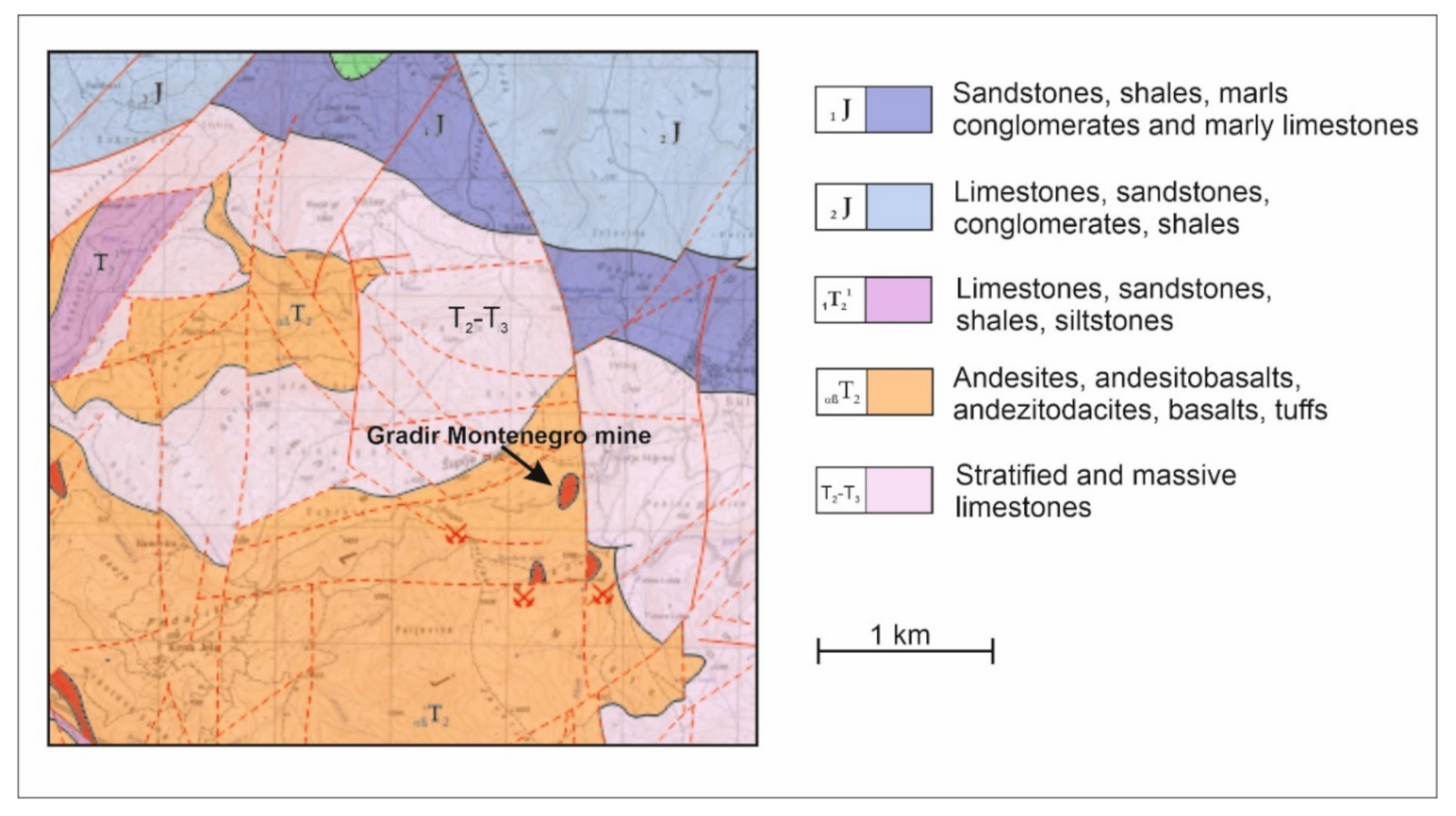
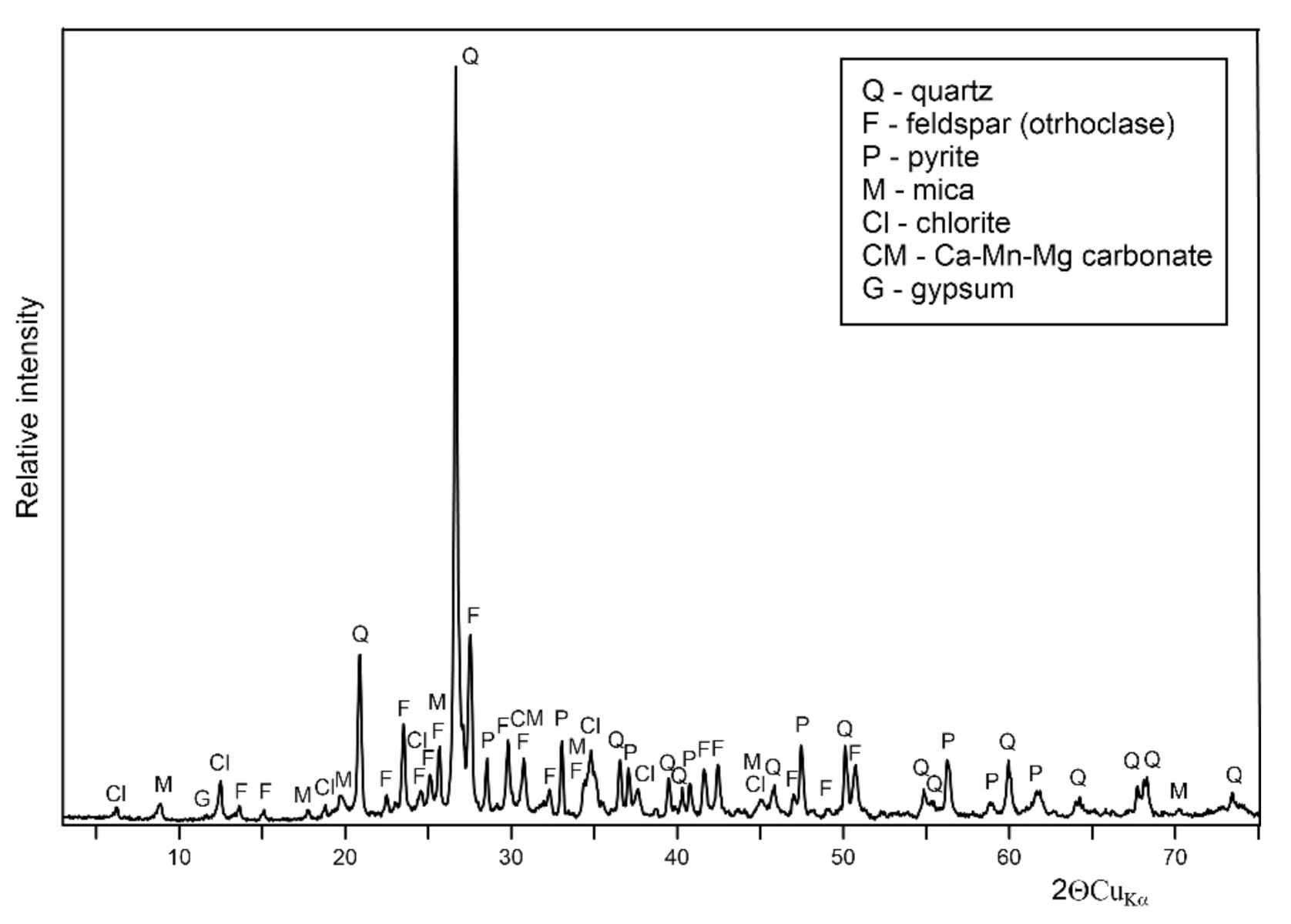
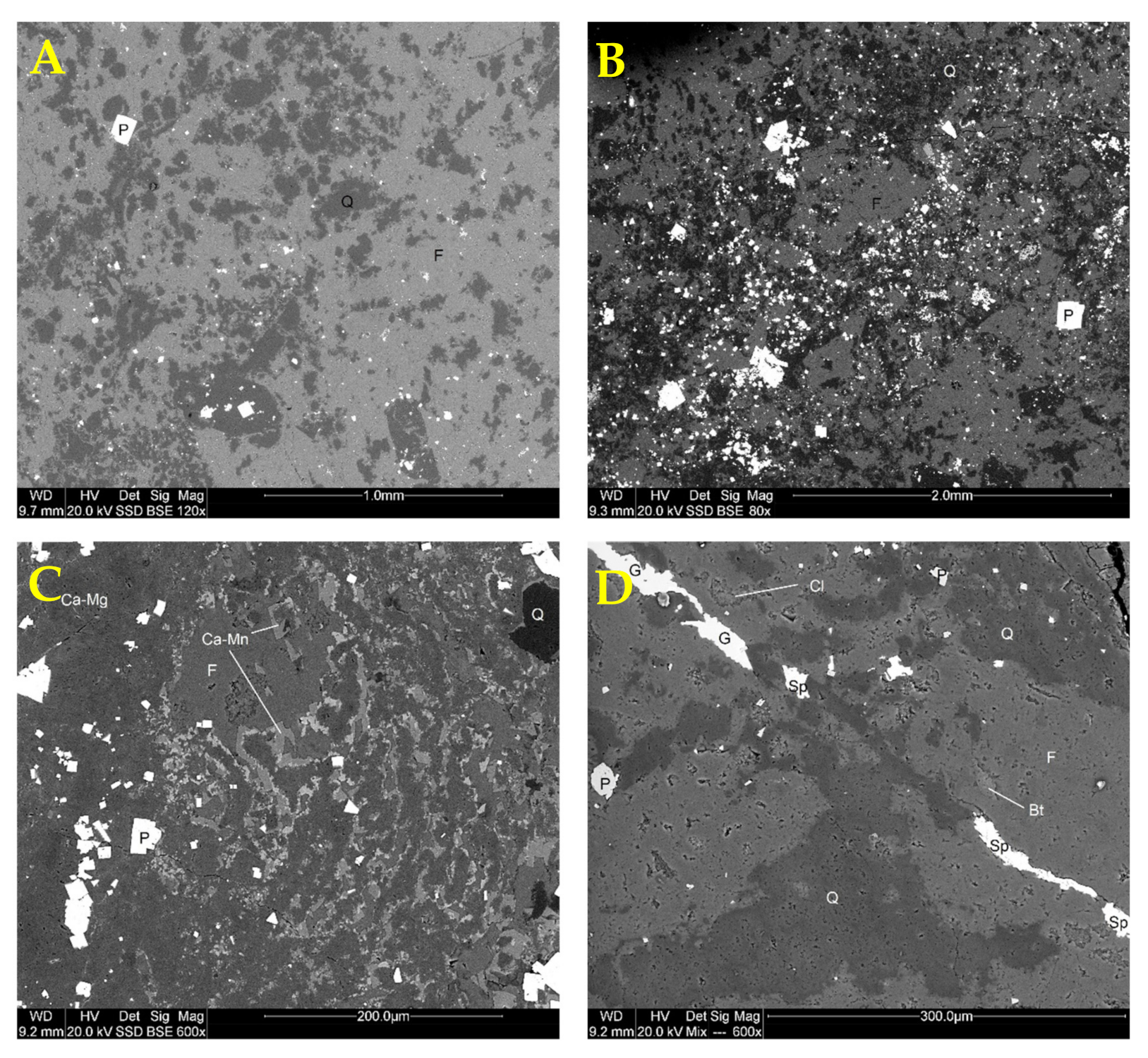
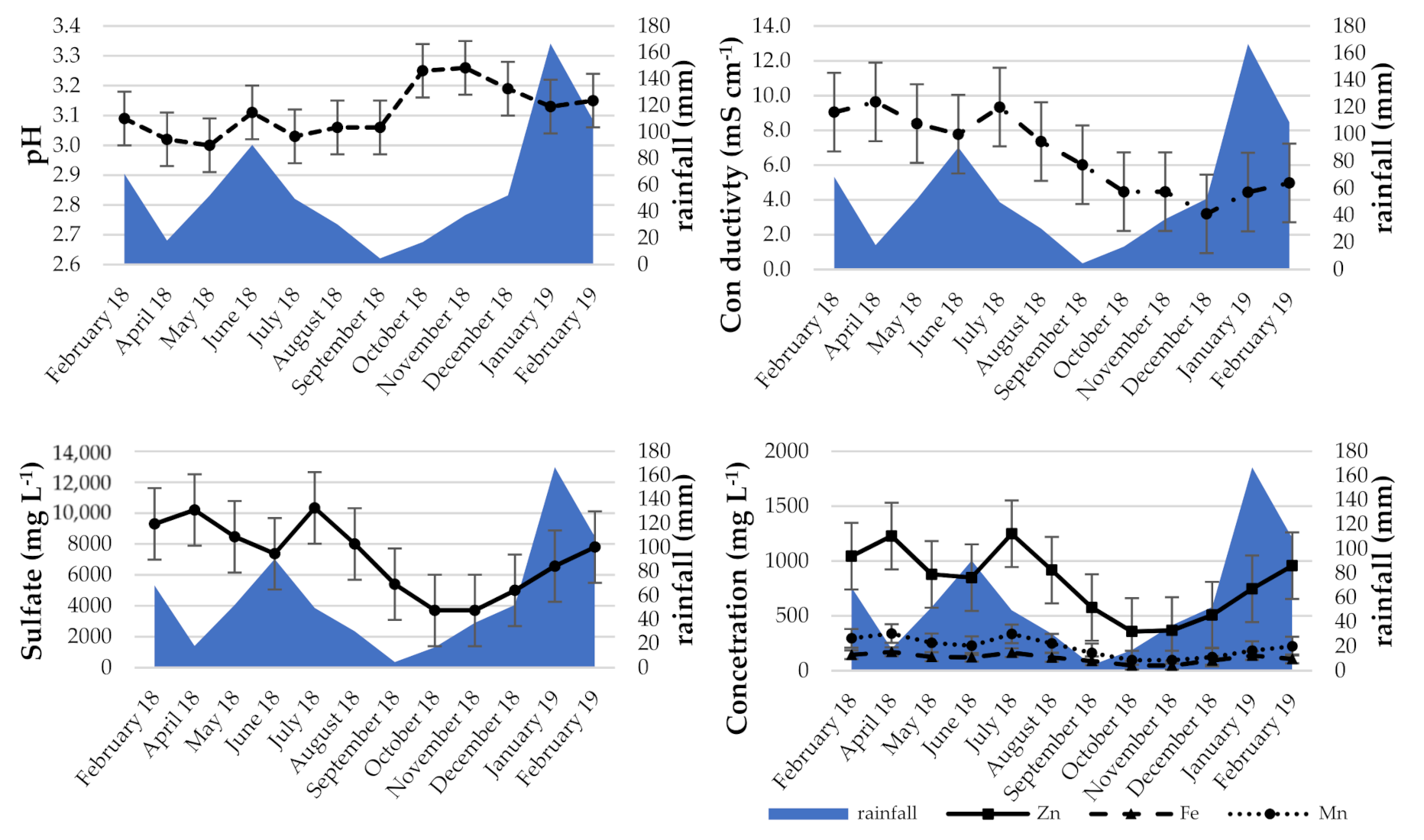


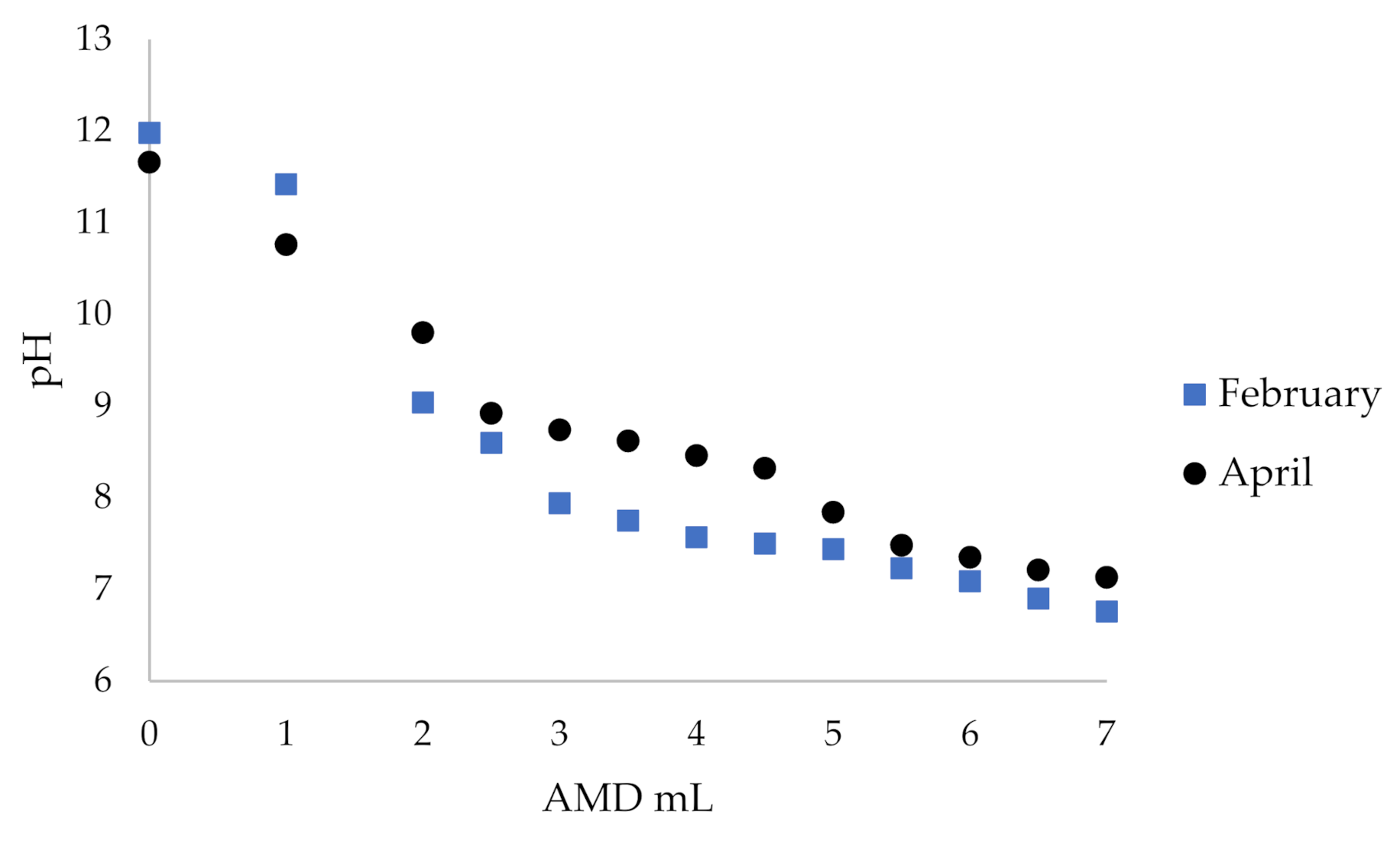
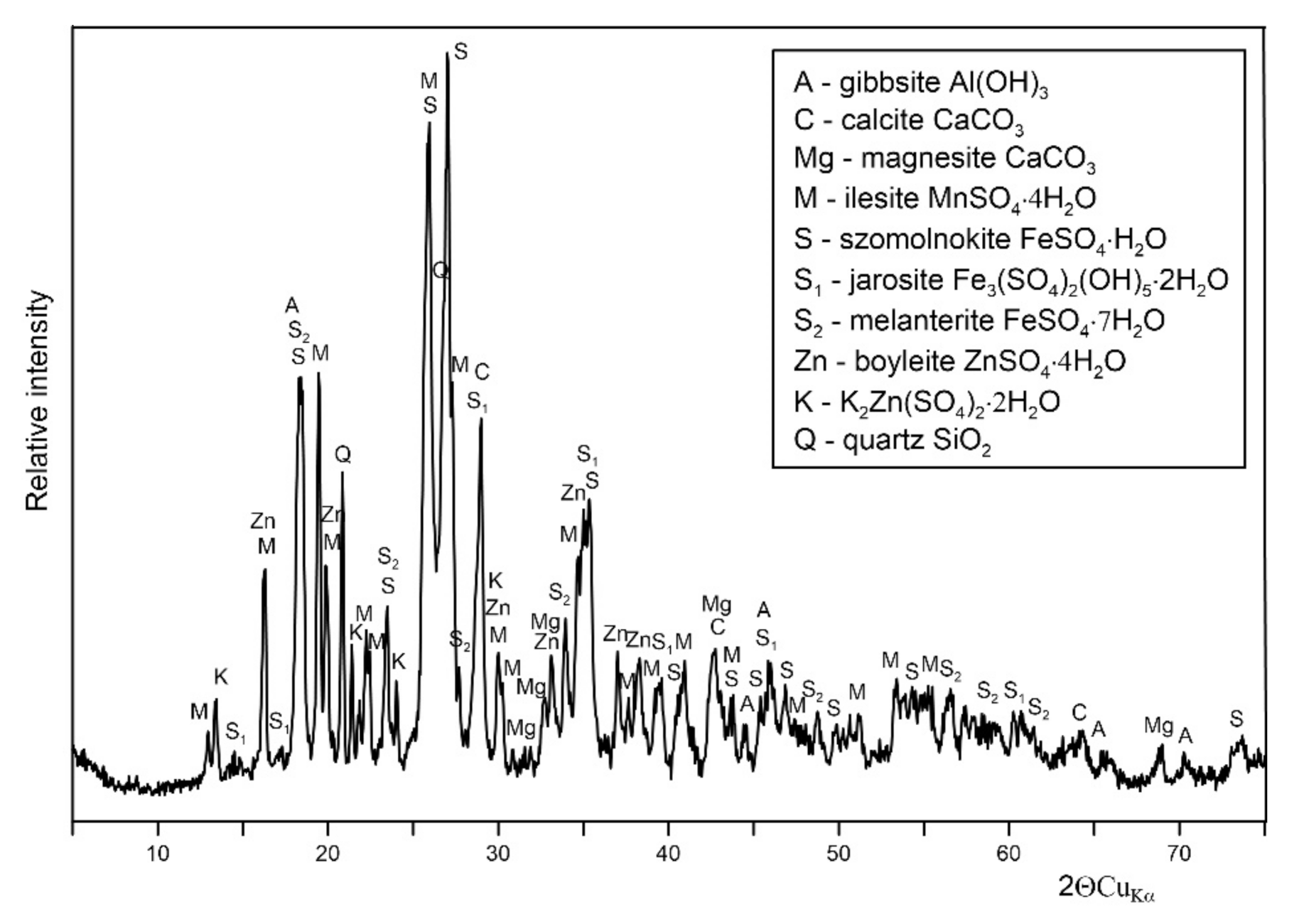
| Element | LOQ (mg·L−1) | Element | LOQ (mg·L−1) |
|---|---|---|---|
| Al | 0.01 | Mg | 0.1 (1.00) |
| Ba | 0.001 (0.1) | Mn | 0.001 (0.01) |
| Ca | 0.1 | Na | 0.5 (50.0) |
| Cd | 0.001 (0.01) | Ni | 0.005 (0.5) |
| Co | 0.002 (0.2) | Pb | 0.01 |
| Cu | 0.002 (0.02) | Si (as SiO2) | 0.1 |
| Fe | 0.01 (0.1) | Sr | 0.002 |
| K | 0.5 (50.0) | Zn | 0.003 |
| Element | LOQ (mg·L−1) |
|---|---|
| Cl− | 0.5 (15.0) |
| NO3− | 0.01 (3.00) |
| SO4− | 0.5 |
| Main Oxides (wt. %) | Trace Elements (mg kg−1) | ||
|---|---|---|---|
| SiO2 | 54.5 | As | 202 |
| TiO2 | 0.60 | Br | bd |
| Al2O3 | 16.2 | Cl | 85 |
| Fe2O3 | 8.22 | Co | 84 |
| CaO | 0.92 | Cr | 73 |
| MgO | 2.41 | Cu | 95 |
| MnO | 0.34 | Ni | 46 |
| SrO | 0.02 | Pb | 2995 |
| BaO | 0.51 | Sn | bd |
| Na2O | 0.31 | Zn | 7044 |
| K2O | 7.50 | ||
| P2O5 | 0.12 | ||
| SO3 | 7.05 | ||
| ZrO2 | 0.04 | ||
| LOI | 0.25 | ||
| Parameter | Unit | Flotation Wastewater | AMD | Montenegro Standards | ||
|---|---|---|---|---|---|---|
| Average | SD | Average | SD | |||
| pH | 12.10 | 0.40 | 3.11 | 0.09 | 6.0–8.5 | |
| Conductivity | mS cm−1 | 2.69 | 1.15 | 6.22 | 2.26 | - |
| Cl− | mg L−1 | 9.40 | 2.89 | 23.0 | 20.1 | - |
| NO3− | 3.04 | 1.14 | 7.10 | 38.6 | 50 | |
| SO42− | 774 | 208 | 6769 | 2312 | 20 | |
| Al | 0.22 | 0.13 | 88.0 | 36.1 | 3.0 | |
| Ca | 469 | 111 | 386 | 19.2 | - | |
| Cd | <0.01 | - | 0.90 | 0.31 | 0.01 | |
| Co | <0.02 | - | 0.51 | 0.15 | 1.0 | |
| Cu | <0.02 | - | 1.25 | 1.13 | 0.5 | |
| Fe | <0.1 | - | 107 | 40.0 | 2.0 | |
| K | 31.3 | 7.03 | <50.0 | - | - | |
| Mg | <1.00 | - | 880 | 320 | - | |
| Mn | 0.01 | 0.02 | 199 | 84.8 | 2.5 | |
| Na | 57.9 | 15.8 | <50.0 | - | - | |
| Ni | <0.05 | - | 0.86 | 0.23 | 1.25 | |
| Pb | 0.55 | 0.94 | 0.24 | 0.06 | 0.5 | |
| SiO2 | 2.67 | 1.25 | 66.4 | 17.2 | - | |
| Sr | 0.79 | 0.21 | 1.77 | 0.05 | - | |
| Zn | 0.06 | 0.11 | 746 | 303 | 1 | |
| Water | Flotation Wastewater | Acid Mine Drainage | ||||
|---|---|---|---|---|---|---|
| Weight (g) | pH | Conductivity (mS·cm−1) | pH | Conductivity (mS·cm−1) | pH | Conductivity (mS·cm−1) |
| Short-term stored waste rocks | ||||||
| 0 | 7.00 | 0.795 | 12.37 | 2.06 | 2.83 | 5.21 |
| 1 | 7.99 | 0.859 | 11.85 | 1.66 | 3.57 | 5.33 |
| 4 | 7.35 | 2.14 | 9.14 | 1.15 | 4.57 | 5.14 |
| 6 | 7.27 | 1.42 | 8.96 | 1.26 | 5.44 | 5.07 |
| 10 | 7.41 | 2.33 | 7.86 | 1.62 | 5.70 | 5.06 |
| Long-term stored waste rocks | ||||||
| 0 | 7.00 | 0.795 | 12.37 | 2.06 | 2.83 | 5.21 |
| 1 | 7.60 | 1.20 | 10.10 | 1.81 | 3.33 | 5.39 |
| 4 | 7.31 | 2.09 | 8.22 | 1.77 | 6.14 | 4.68 |
| 6 | 7.14 | 2.12 | 7.45 | 1.71 | 6.03 | 4.57 |
| 10 | 7.07 | 2.21 | 7.14 | 1.82 | 6.24 | 4.15 |
| Medium | Parameter | Time (h) | ||||
|---|---|---|---|---|---|---|
| 0 | 24 | 48 | 72 | 96 | ||
| AMD + waste rocks | pH | 2.85 | 6.08 | 6.24 | 6.43 | 6.41 |
| SD | 0.03 | 0.17 | 0.10 | 0.15 | 0.17 | |
| Conductivity (mS·cm−1) | 8.15 | 6.43 | 6.56 | 6.17 | 6.23 | |
| SD | 0.09 | 0.13 | 0.25 | 0.27 | 0.30 | |
| SO42− (mg·L−1) | 8110 | - | - | - | 5627 | |
| SD | 59 | - | - | - | 105 | |
| Flotation wastewater + waste rocks | pH | 11.14 | 6.60 | 6.74 | 6.64 | 6.61 |
| SD | 0.10 | 0.08 | 0.06 | 0.05 | 0.08 | |
| Conductivity (mS·cm−1) | 2.20 | 2.72 | 2.78 | 2.69 | 2.78 | |
| SD | 0.02 | 0.05 | 0.02 | 0.06 | 0.06 | |
| SO42− (mg·L−1) | 991 | - | - | - | 1634 | |
| SD | 48 | - | - | - | 61 | |
| Flotation wastewater + AMD + waste rocks | pH | 9.02 | 6.56 | 6.72 | 6.70 | 6.68 |
| SD | 0.03 | 0.02 | 0.02 | 0.09 | 0.05 | |
| Conductivity (mS·cm−1) | 2.14 | 2.77 | 2.86 | 2.74 | 2.84 | |
| SD | 0.05 | 0.04 | 0.07 | 0.02 | 0.15 | |
| SO42− (mg·L−1) | 1204 | - | - | - | 1713 | |
| SD | 58 | - | - | - | 29 | |
| Water + waste rocks | pH | 6.65 | 6.58 | 6.85 | 6.75 | 6.78 |
| SD | 0.03 | 0.04 | 0.04 | 0.06 | 0.06 | |
| Conductivity (mS·cm−1) | 0.0055 | 2.54 | 2.62 | 2.54 | 2.63 | |
| SD | 0.0001 | 0.04 | 0.02 | 0.01 | 0.02 | |
| SO42− (mg·L−1) | 2 | - | - | - | 1505 | |
| SD | 0.03 | - | - | - | 16 | |
| Parameter | Unit | AMD | Flotation Wastewater | AMD + Waste Rocks | Flotation Wastewater + Waste Rocks | Flotation Wastewater + AMD + Waste Rocks | Water + Waste Rocks | ||||||
|---|---|---|---|---|---|---|---|---|---|---|---|---|---|
| Average | SD | Average | SD | Average | SD | Average | SD | Average | SD | Average | SD | ||
| pH | 2.85 | 0.03 | 11.14 | 0.10 | 6.41 | 0.17 | 6.61 | 0.08 | 6.68 | 0.05 | 6.78 | 0.06 | |
| Conductivity | mS·cm−1 | 8.15 | 0.09 | 2.20 | 0.02 | 6.23 | 0.30 | 2.78 | 0.06 | 2.83 | 0.15 | 2.63 | 0.02 |
| Al | mg·L−1 | 127 | 31.8 | 0.12 | 0.03 | <0.1 | - | <0.02 | - | <0.02 | - | <0.02 | - |
| Ca | 384 | 96.0 | 341 | 85 | 446 | 116 | 571 | 143 | 574 | 144 | 575 | 144 | |
| Cd | 1.41 | 0.35 | <0.01 | - | 0.48 | 0.12 | 0.05 | 0.01 | 0.06 | 0.02 | 0.06 | 0.02 | |
| Co | 0.63 | 0.16 | <0.02 | - | 0.66 | 0.17 | 0.09 | 0.02 | 0.09 | 0.02 | 0.10 | 0.03 | |
| Cu | 3.49 | 0.87 | <0.02 | - | <0.05 | - | 0.01 | 0.003 | 0.01 | 0.003 | 0.01 | 0.003 | |
| K | <50 | - | 40.5 | 10.1 | 25.2 | 6.30 | 34.5 | 8.63 | 34.0 | 8.50 | 19.2 | 4.80 | |
| Mg | 964 | 241 | <1 | - | 956 | 239 | 57.9 | 14.5 | 81.5 | 20.4 | 51.9 | 13.0 | |
| Mn | 224 | 56.0 | <0.01 | - | 220 | 55.0 | 33.8 | 8.45 | 35.5 | 8.88 | 29.4 | 7.35 | |
| Mo | <0.3 | - | <0.03 | - | <0.05 | - | 0.01 | 0.003 | 0.01 | 0.00 | 0.01 | 0.00 | |
| Na | <50 | - | 66.0 | 16.5 | 8.03 | 2.01 | 52.7 | 13.2 | 51.0 | 12.8 | 2.23 | 0.56 | |
| Ni | 0.95 | 0.24 | <0.05 | - | 0.60 | 0.15 | 0.07 | 0.02 | 0.08 | 0.02 | 0.08 | 0.02 | |
| Pb | 0.19 | 0.05 | 0.23 | 0.06 | 0.46 | 0.12 | 0.08 | 0.02 | 0.06 | 0.02 | 0.05 | 0.01 | |
| SiO2 | 76.5 | 19.1 | 4.80 | 1.20 | 19.8 | 4.95 | 13.1 | 3.28 | 15.1 | 3.78 | 14.3 | 3.58 | |
| Sr | 1.83 | 0.46 | 1.13 | 0.28 | 1.56 | 0.39 | 1.10 | 0.28 | 1.14 | 0.29 | 0.75 | 0.19 | |
| Zn | 957 | 239 | 0.43 | 0.11 | 204 | 51.0 | 8.15 | 2.04 | 7.99 | 2.00 | 11.5 | 2.88 | |
| SO42− | 8110 | 59 | 991 | 48 | 5626 | 105 | 1633 | 61.0 | 1713 | 29.00 | 1505 | 16.0 | |
Publisher’s Note: MDPI stays neutral with regard to jurisdictional claims in published maps and institutional affiliations. |
© 2020 by the authors. Licensee MDPI, Basel, Switzerland. This article is an open access article distributed under the terms and conditions of the Creative Commons Attribution (CC BY) license (http://creativecommons.org/licenses/by/4.0/).
Share and Cite
Retka, J.; Rzepa, G.; Bajda, T.; Drewniak, L. The Use of Mining Waste Materials for the Treatment of Acid and Alkaline Mine Wastewater. Minerals 2020, 10, 1061. https://doi.org/10.3390/min10121061
Retka J, Rzepa G, Bajda T, Drewniak L. The Use of Mining Waste Materials for the Treatment of Acid and Alkaline Mine Wastewater. Minerals. 2020; 10(12):1061. https://doi.org/10.3390/min10121061
Chicago/Turabian StyleRetka, Jacek, Grzegorz Rzepa, Tomasz Bajda, and Lukasz Drewniak. 2020. "The Use of Mining Waste Materials for the Treatment of Acid and Alkaline Mine Wastewater" Minerals 10, no. 12: 1061. https://doi.org/10.3390/min10121061
APA StyleRetka, J., Rzepa, G., Bajda, T., & Drewniak, L. (2020). The Use of Mining Waste Materials for the Treatment of Acid and Alkaline Mine Wastewater. Minerals, 10(12), 1061. https://doi.org/10.3390/min10121061






